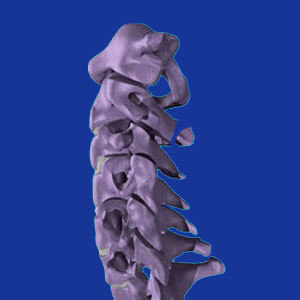
Suffering a cervical spinal fracture may or may not be painful. Additionally, some fractures only require monitoring, while others necessitate active care. All fractures present uniquely, making this a difficult article to write when it comes to providing a general overview of the causes, symptoms and best path towards treatment of spinal fractures in the neck.
Spinal fractures sound like universally catastrophic occurrences to laymen and they can certainly become dire health threats. However, there are also many fractures that are not overly serious and many that do not even produce pain, even when they do feature pathological potential.
The goal of this essay is to provide a glimpse at some of the most common varieties of cervical spinal fracture, including the causes, symptoms and treatment options.
Typical Causes of Cervical Spinal Fracture
Fractures in the neck can occur from the usual reasons, including motor vehicle collisions, falls, sporting injuries, acts of violence and other forms of trauma. However, there are other, lesser known causes of cervical spine fracture that can also create breaks in one or more vertebral bones:
Bone density issues, like osteoporosis and osteopenia, leave bones weak and porous, facilitating fracture. Some diseases can also attack the structural integrity of the bones, inciting the tendency to fracture.
Old age itself has pathological effects on the spine and many elders demonstrate brittle and delicate bones that can fracture without substantial trauma.
Obese people are at high risk for suffering compression fractures, especially when getting older. The weight of the body alone is enough to create fractures in a compromised and overstressed spinal column, although compression fractures in the obese are certainly more common in the lumbar region than in the neck.
Some developed or congenital spinal abnormalities can increase the risk of cervical fracture, including facet joint hypertrophy, spondylolisthesis, hypolordosis and organic fusions of the C-spine.
Usual Symptoms of Cervical Vertebral Fracture
Trauma-induced fractures will usually be acutely painful, although some might involve less significant breaks that might only produce minor pain, especially when located on the various spinal processes. However, usually pain is severe enough to warrant medical imaging investigation which should detect most fractures.
Compression fractures, osteoporosis-related fractures and certain types of other breaks might not be painful at all, may only produce limited and occasional or transient symptoms or might produce different types of expressions, such as neurological consequences without any pain.
Fractures which occur due to chronically or recurrent painful spinal abnormalities, like pathological spondylolisthesis, facet hypertrophy or lordotic changes may be overlooked as just another flare-up of normal pain. This is why so many of these fractures go unnoticed for some time and often are diagnosed after they have already healed organically.
Best Treatment for Cervical Spinal Fracture
Most fractures will only require symptomatic care. The patient might need pain management and may also benefit from orthotic devices which might restrict neck movement in order to allow full healing of fractures which demonstrate the danger of migration.
Some fractures might require more dramatic measures in order to correct them. There are specific procedures which can address certain types of cervical spinal fracture, including kyphoplasty and vertebroplasty. However, many fractures might involve damage to the central or foraminal spinal canals, and are often therefore also treated with some general neck surgery technique, such as laminectomy, corpectomy or spinal fusion (spondylodesis).
Many fractures will benefit from rehabilitative physical therapy after they are healed. This type of treatment will help to restore full physical functionality after the injury resolves. It is advisable to discuss treatment with your physician and physical therapist and always make sure to consult with a neurologist if any threat exists to the spinal cord or nerves. When monitored or treated properly, most cervical fractures can be fixed without the patient suffering any lingering consequences. Patients should be cautious when seeking complementary care when a possible undiagnosed fracture exists, since aggressive massage and chiropractic manipulation can aggravate fractures and even create the potential for spinal cord injury.
Neck Pain > Neck Injury > Cervical Spinal Fracture





